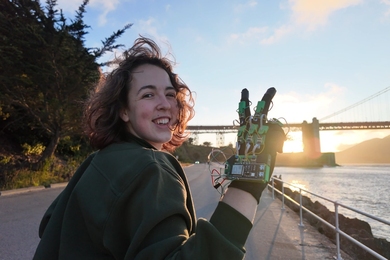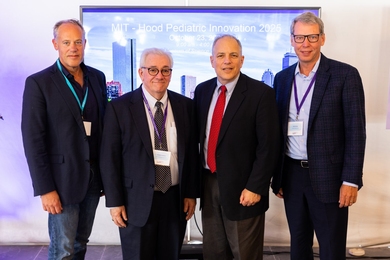With MIT-trained astronaut Janice Voss aboard as payload commander, the recently returned Shuttle Radar Topography Mission (SRTM) successfully completed its goal of creating a high-resolution digital topographic map of the Earth's surface using a sophisticated synthetic aperture radar system.
When problems with a malfunctioning cold gas thruster on the SRTM hardware threatened to curtail the mapping mission, Draper Laboratory engineers improved the flight control software to reduce the shuttle's propellant consumption while maintaining its pointing accuracy.
The result is a high-resolution digital elevation map covering 80 percent of the Earth's surface, which promises to assist scientists (including several at MIT) in research on modeling the earth's surface and the evolution of its landscape.
The mission was Dr. Voss' fifth flight into space, making a four-way tie for the record number of space flights by a woman astronaut (joining Shannon Lucid, Bonnie Dunbar and Tamara Jernigan). When asked about this achievement, she said, "I don't think of it as a record, but more as a work in progress," as she looks forward to future missions on both the space shuttle and the international space station.
Dr. Voss received the SM in electrical engineering in 1977 and the PhD in aeronautics and astronautics in 1987 (both from MIT) before being chosen as a NASA astronaut in 1990. While at MIT, she was a Draper Laboratory Fellow and worked on developing software for the space shuttle program. Her PhD thesis involved developing algorithms to identify frequencies, damping and mode shapes for the International Space Station.
"Draper Lab did a great job supporting this flight, both in the preflight preparations and developing work-arounds for the thruster problem encountered during the flight," Dr. Voss said.
The Draper Lab team was responsible for characterizing the mass properties of the SRTM radar mast, which was extended 197 feet from Endea-vour's payload bay. Using the shuttle's inertial measurement unit as well as sensors on the SRTM payload, Draper engineers determined the natural frequency, amplitude and damping characteristics of the combined structure and verified that the shuttle's attitude control system would remain stable when the mast was fully deployed.
"SRTM was the most flexible structure we've flown in space and it required the tightest pointing accuracy to support the mapping mission," said Draper's Mark Jackson (SM 1994 in aero/astro).
"This was one of the most complex shuttle missions in terms of the flight control system interaction with the shuttle's payload," said Les Sackett of Draper.
When a nitrogen gas thruster at the end of the SRTM mast failed to operate, the Draper team worked around the clock to develop new flight control procedures that would minimize the shuttle's thruster propellant consumption while continuing to provide a stable platform which could point the SRTM radar system with a high degree of accuracy.
"We literally saved a day of science through the outstanding efforts of the Draper team that helped solve this problem," said Doug Zimpfer, group leader of Draper's Aerospace Controls Group.
"This was an exciting mission to support in that everyone pulled together as a team -- flight operations, flight control, structures, payload and mission management -- to solve the propellant issue and extend the duration of the mission," said Draper's Jennifer Hamelin. "It is very rewarding to see that our extra effort resulted in mission success."
The original goal of the SRTM mission was to create a digital topographic map of the Earth's surface, consisting of contours with 30-meter horizontal spacing and with a vertical resolution of 10 meters in relative height and 16 meters in absolute elevation. Preliminary results from the mission indicate that the actual mapping resolution may be improved by a factor of three because of improved SRTM attitude and pointing accuracy, reduced thermal expansion and bending of the SRTM mast, and improvements in the electrical phase error of the measured signal.
MIT BENEFITS
Several MIT scientists plan on using SRTM data in their research. Professor Rafael Bras, head of the Department of Civil and Environmental Engineering (CEE), plans on using the digital elevation maps developed from this mission to continue his research in landscape modeling.
"The availability of high-resolution topographic maps worldwide will allow us to test a unique model of landscape evolution that we have developed over the last 10 years," he said. "We intend to use the model and the mission data to study the quickly eroding terrain of the Loess Plateau in the upper reaches of the Yellow River in China and the landslide-prone region of the Appenines in Italy. The data will also allow us to test hypotheses of the relationship between landscape morphology and its forming processes and climate, as well as hypotheses that we have developed over many years relative to the self-organization and fractal nature of river basins and landscapes."
Professor Bras's research is expected to have significant implications in the fields of hydrology, disaster prevention and management, and land use management. His science team includes Professor Kelin Whipple of earth, atmospheric and planetary sciences (EAPS) and Dr. Greg Tucker, a CEE research associate.
"My research group has been waiting for years for the SRTM data to finally become a reality," said Professor Whipple. "Digital topographic maps are a critical data resource in studies of landscape evolution and neotectonics. The availability of digital elevation models has helped spur a revolution in geomorphology -- providing the data resources to develop and test theories of landscape evolution."
Professor Daniel Rothman of EAPS is also planning to use SRTM data in his research. "We are analyzing the structure of several of the world's largest rivers to test our theories of landscape structure and erosion," he said. "Currently available data often limits us to one kilometer of horizontal resolution. Though this is useful for some purposes, the prospect of access to vastly improved horizontal resolution (30 meters) means that we will not only have much better data, but also more stringent tests of our theories."
A version of this article appeared in MIT Tech Talk on March 8, 2000.







